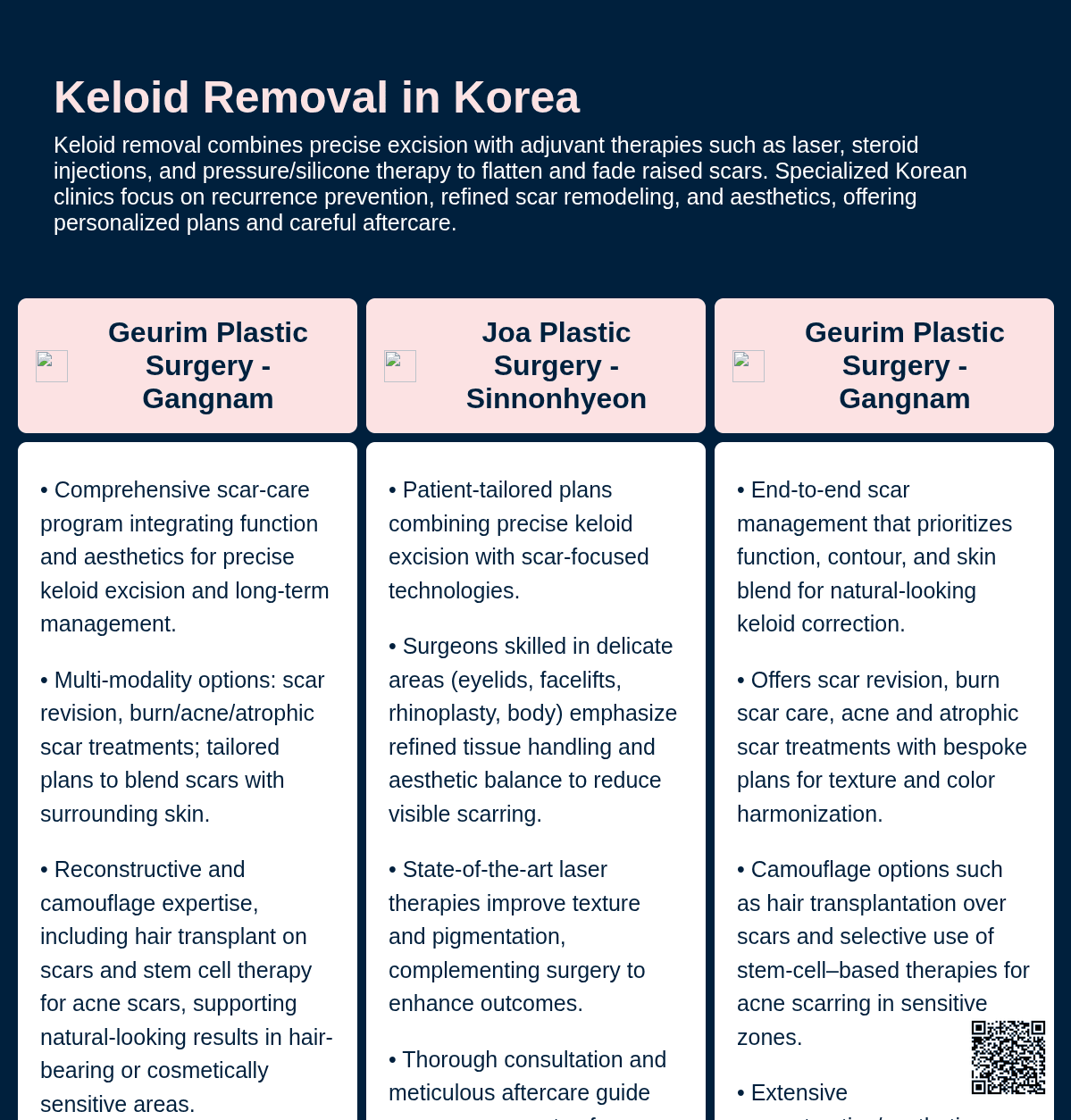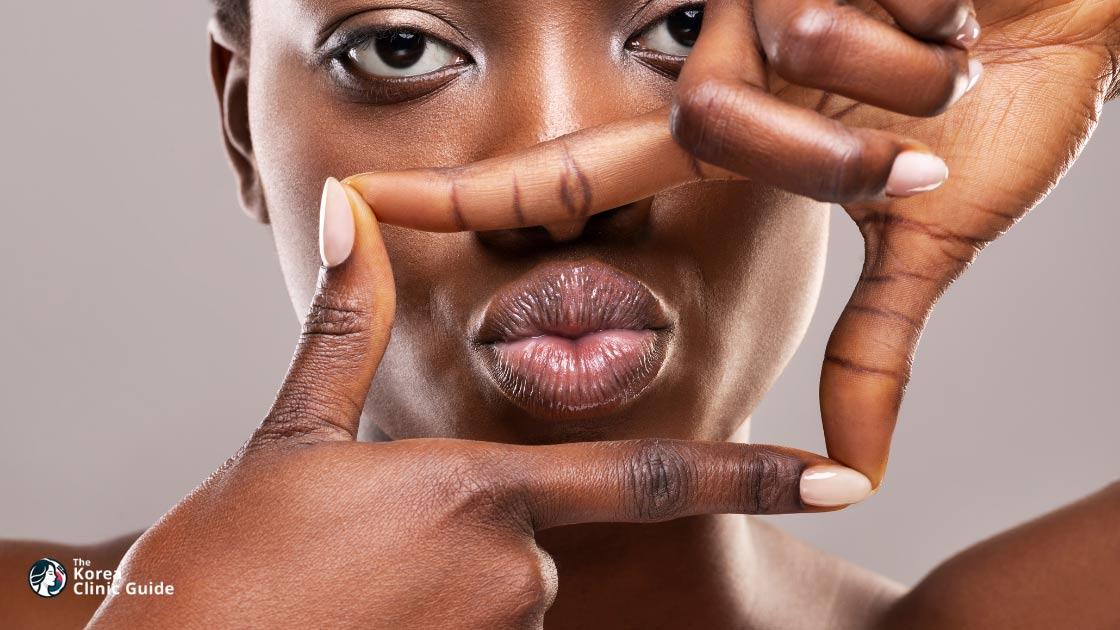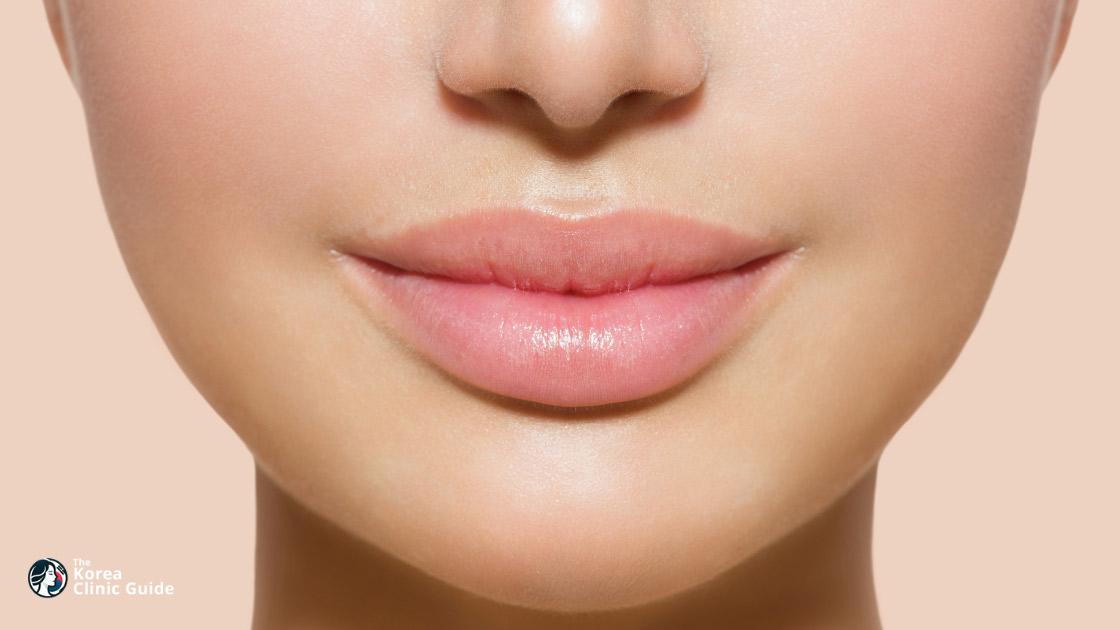Medical Tourism Blog
Keloid Removal in Korea | Best Clinics, Costs, Procedure Types & More

Table of contents
- What Is Keloid Removal?
- Best Clinics in Korea for Keloid Removal
- Getting Keloid Removal in Korea
- Cost of Keloid Removal in Korea
- Alternatives to Keloid Removal
- Conclusion
Considering treatment in Korea? Everything you need to know e.g. — how to avoid scams, visas, interpreters, recovery tips — in our Medical Tourism Master Guide. Plan with confidence in minutes, not weeks!
Are you or someone you know struggling with unsightly and often uncomfortable keloids? Discover how innovative treatments in Korea are transforming the landscape of keloid removal, offering hope and effective solutions through cutting-edge technology and skilled practitioners.
What Is Keloid Removal?
Keloid removal is a medical procedure designed to treat keloids, which are raised, thickened areas of scar tissue that develop where the skin has healed after an injury. Keloids can become larger than the original wound, extending beyond the boundaries of the injury. They often result in notable disfigurement, discomfort, and itching, thus necessitating medical intervention for cosmetic and functional reasons.
Types of Keloid Removal Procedures
-
Surgical Excision: Surgical excision involves carefully cutting out the keloid under local anesthesia. This procedure is usually conducted by a dermatologist or a plastic surgeon. Post-surgical care is essential to prevent the keloid from returning, which may include applying pressure dressings or silicone sheets and receiving steroid injections into the scar site.
-
Cryotherapy: Cryotherapy entails using extreme cold via liquid nitrogen to freeze and reduce the size of the keloid. This method is often effective for smaller keloids and is generally performed over several sessions. While cryotherapy can reduce the size and thickness of the keloid, it may sometimes cause hypopigmentation or skin discoloration.
-
Corticosteroid Injections: Corticosteroid injections are commonly used to flatten and reduce the size of keloids. These injections can help to break down the excess collagen that forms the keloid. The procedure is typically repeated every few weeks until the desired flattening is achieved. Side effects may include skin thinning or discoloration at the injection site.
-
Laser Therapy: Laser therapy involves using focused light beams to remove the keloid tissue layer by layer. This method can improve the texture and color of the skin, making the keloid less noticeable. Lasers can also reduce itchiness and discomfort. Multiple sessions may be required, and combining laser therapy with other treatments like corticosteroid injections can enhance effectiveness.
-
Radiation Therapy: Radiation therapy is employed in cases where other treatment methods have failed to yield satisfactory results. Low-dose radiation can be targeted at the keloid following surgical excision to inhibit the recurrence of scar tissue formation. Care must be taken with this method due to potential risks associated with radiation.
-
Silicone Gel Sheets and Pressure Therapy: Non-invasive methods like silicone gel sheets and pressure therapy can also be effective, especially when used after surgical removal or corticosteroid injections. These treatments help flatten and soften the keloid over time, making them less prominent.
Pre-Procedure Considerations
Before undergoing keloid removal, several pre-procedure considerations are essential. A thorough medical history and physical examination are conducted to ascertain the specific characteristics of the keloid and determine the most effective treatment method. Factors such as skin type, keloid location, size, and duration are critical in planning the appropriate intervention.
Post-Procedure Care
Post-procedure care is crucial in preventing keloid recurrence and ensuring optimal healing. This may include:
- Application of Topical Medications: Antibiotic ointments or other prescribed topical treatments to prevent infection and promote healing.
- Follow-Up Appointments: Regular check-ups to monitor the healing process and administer additional treatments if necessary.
- Use of Compression Dressings or Silicone Sheets: To maintain pressure on the treated area and prevent the keloid from re-forming.
- Avoiding Sun Exposure: Protecting the area from UV rays to prevent pigmentation changes.
Risks and Complications
Like any medical procedure, keloid removal carries potential risks and complications. These may include infection, bleeding, and the recurrence of the keloid. Scarring, skin discoloration, and changes in skin texture are also possible. It is essential to discuss these risks with the healthcare provider before proceeding with the treatment.
Who is Keloid Removal for?
- Individuals with Discomfort or Pain: A keloid can feel uncomfortable, itchy, or painful. Those experiencing significant discomfort may benefit from removal.
- People with Limited Mobility: Keloids that develop over a joint, such as a shoulder, can limit movement. Removal may improve mobility and quality of life.
- Aesthetic Concerns: Many people simply dislike the way keloids look and may wish to have them removed for cosmetic reasons.
- Ear Keloid Sufferers: Those with keloids on their earlobes or other parts of the ear, often due to piercings, might seek removal to wear earrings again or for aesthetic reasons.
- Patients with Chronic Symptoms: If a keloid continues to grow and is associated with chronic symptoms such as persistent itching or tenderness, removal combined with additional treatments might provide relief.
- Special Skin Conditions: People with other skin conditions that may mimic keloids, such as allergic reactions or skin cancer, should be properly diagnosed and may benefit from keloid removal to rule out these conditions.
It is important for individuals to consult with a board-certified dermatologist to tailor a treatment plan that addresses their specific needs and skin responses.
Best Clinics in Korea for Keloid Removal
Listed below are the best clinics in Korea for keloid removal:
| Clinic Name | Key Features | Special Techniques |
|---|---|---|
| Geurim Plastic Surgery Website | Geurim Plastic Surgery in Gangnam stands out as the best choice for keloid removal in Korea because it treats keloids within a truly comprehensive scar-care program that prioritizes both aesthetics and function. Beyond dedicated Keloid Removal, the clinic offers Scar Revision Surgery, Burn Scar Treatment, Acne Scar Treatment, and Atrophic Scar Treatment, enabling tailored plans to improve scar texture, blend with surrounding skin, and minimize visibility. Its reconstructive and camouflage capabilities—such as [Hair Transplant on Scar](/blog/hair-transplant-on-scar-korea)—and advanced options like stem cell therapy for acne scars further support natural-looking results in hair-bearing or cosmetically sensitive areas. Coupled with broad surgical expertise spanning cleft lip and palate repair, facial contouring, and nasal refinement, Geurim can customize treatment to the scar’s location and the patient’s overall features, delivering harmonious, nuanced outcomes that set a high standard for keloid care. | Hair Transplant on Scar; stem cell therapy for acne scars; reconstructive and camouflage capabilities; broad surgical expertise spanning cleft lip and palate repair, facial contouring, and nasal refinement. |
| Joa Plastic Surgery Website | Joa Plastic Surgery, conveniently located near Sinnonhyeon Station, is the best choice for keloid removal in Korea thanks to its comprehensive, patient-tailored approach that blends surgical precision with advanced scar-focused technology. With extensive experience across delicate surgical areas—from eyelids and facelifts to rhinoplasty and body procedures—the clinic’s surgeons prioritize refined tissue handling and aesthetic balance, critical for excising keloids while minimizing visible scarring. Their state-of-the-art laser treatments further help improve scar texture and pigmentation, complementing surgical care to enhance outcomes. Every journey begins with a personalized consultation to address your unique skin and healing profile, and is supported by meticulous aftercare designed to guide recovery and reduce the risk of recurrence. Grounded in an ethos of enhancing natural beauty and confidence, Joa Plastic Surgery offers the expertise, technology, and continuity of care that discerning patients seek for safe, effective keloid management. | State-of-the-art laser treatments; extensive experience across delicate surgical areas—from eyelids and facelifts to rhinoplasty and body procedures; refined tissue handling and aesthetic balance; personalized consultation and meticulous aftercare. |
Geurim Plastic Surgery
Geurim Plastic Surgery in Gangnam stands out as the best choice for keloid removal in Korea because it treats keloids within a truly comprehensive scar-care program that prioritizes both aesthetics and function. Beyond dedicated Keloid Removal, the clinic offers Scar Revision Surgery, Burn Scar Treatment, Acne Scar Treatment, and Atrophic Scar Treatment, enabling tailored plans to improve scar texture, blend with surrounding skin, and minimize visibility. Its reconstructive and camouflage capabilities—such as Hair Transplant on Scar—and advanced options like stem cell therapy for acne scars further support natural-looking results in hair-bearing or cosmetically sensitive areas. Coupled with broad surgical expertise spanning cleft lip and palate repair, facial contouring, and nasal refinement, Geurim can customize treatment to the scar’s location and the patient’s overall features, delivering harmonious, nuanced outcomes that set a high standard for keloid care.
Find more about this clinic here: Geurim Plastic Surgery Website
Joa Plastic Surgery
Joa Plastic Surgery, conveniently located near Sinnonhyeon Station, is the best choice for keloid removal in Korea thanks to its comprehensive, patient-tailored approach that blends surgical precision with advanced scar-focused technology. With extensive experience across delicate surgical areas—from eyelids and facelifts to rhinoplasty and body procedures—the clinic’s surgeons prioritize refined tissue handling and aesthetic balance, critical for excising keloids while minimizing visible scarring. Their state-of-the-art laser treatments further help improve scar texture and pigmentation, complementing surgical care to enhance outcomes. Every journey begins with a personalized consultation to address your unique skin and healing profile, and is supported by meticulous aftercare designed to guide recovery and reduce the risk of recurrence. Grounded in an ethos of enhancing natural beauty and confidence, Joa Plastic Surgery offers the expertise, technology, and continuity of care that discerning patients seek for safe, effective keloid management.
Find more about this clinic here: Joa Plastic Surgery Website
Getting Keloid Removal in Korea

Keloid removal is a medical procedure designed to eliminate or reduce the size of keloids, which are thick, raised scars that extend beyond the original wound site. In Korea, this procedure has gained attention not only for its effectiveness but also for the advanced techniques and state-of-the-art facilities utilized. Keloid removal in Korea typically involves a multi-faceted approach, incorporating various therapies and methodologies to achieve the best results.
Initial Consultation
The process begins with an initial consultation where a dermatologist or a plastic surgeon evaluates the keloid scars. This involves a detailed medical history review and a physical examination of the keloid. The specialist will assess the size, location, and severity of the keloid, and may also inquire about previous treatments you have undergone.
Treatment Options
Keloid removal treatments in Korea often combine multiple strategies to achieve optimal results. These treatments may include:
-
Corticosteroid Injections: These are the most common first-line treatment for keloids in Korea. The corticosteroids are injected directly into the keloid tissue to reduce inflammation and flatten the scar. The injections are usually given every few weeks, and the total number of sessions varies depending on the keloid's response to the treatment.
-
Surgical Excision: This method involves physically cutting out the keloid. In Korea, surgical excision is often paired with other treatments such as corticosteroid injections or radiotherapy to prevent the keloid from returning. Advanced techniques like laser-assisted excision are also available, which can result in finer surgical precision and reduced recurrence rates.
-
Cryotherapy: This treatment involves freezing the keloid with liquid nitrogen. Cryotherapy works by causing the abnormal scar tissue to die and fall off. It is particularly effective for smaller keloids and is often combined with other treatments to enhance efficacy.
-
Laser Therapy: Laser treatments, such as Pulsed Dye Laser (PDL) or fractional CO2 laser, are used to reduce the redness and size of keloids. These lasers work by targeting the blood vessels within the keloid, which helps flatten and soften the scar. Laser therapy is usually performed in multiple sessions for the best results.
-
Silicone Sheets and Gels: As a non-invasive treatment, silicone can help in flattening and softening keloids. This is often used in conjunction with other treatments to enhance the overall outcome.
-
Radiotherapy: For severe or recurrent keloids, low-dose superficial radiotherapy can be employed. This treatment is usually administered shortly after surgical removal to prevent the keloid from growing back.
Recovery and Aftercare
Post-treatment care is crucial in ensuring the keloid does not recur. Patients are typically advised to keep the treated area clean and to avoid any form of irritation or trauma. Sunscreen should be applied to the area to protect against UV rays, which can exacerbate scarring. Follow-up visits are often scheduled to monitor the healing process and to administer additional treatments if necessary.
In Korean clinics, the use of high-quality aftercare products, such as medical-grade silicone gels and advanced wound care dressings, is emphasized to enhance recovery and minimize scar formation. Many clinics also offer personalized care plans tailored to each patient's specific needs.
Advanced Facilities and Expertise
Korea is renowned for its advanced medical facilities and highly skilled practitioners. Many clinics and hospitals are equipped with the latest technologies and follow stringent safety protocols to ensure high standards of care. Surgeons and dermatologists in Korea are often well-trained and experienced in treating keloids, making it a preferred destination for individuals seeking effective keloid removal.
Final Thoughts on Keloid Removal in Korea
Keloid removal in Korea involves a combination of cutting-edge techniques and expert care. By leveraging multiple treatment modalities and personalized care plans, Korean medical professionals are able to achieve significant improvements in the appearance and texture of keloid scars.
Cost of Keloid Removal in Korea
Keloid removal is a commonly sought medical procedure for patients dealing with this type of scarring. While effectiveness and safety are paramount, the cost is also a significant consideration. Here's a comparative look at the cost of keloid removal in Korea versus other countries, including the USA.
Korea
In Korea, keloid removal is known for its advanced medical technology and experienced dermatologists. The cost of the procedure can vary depending on the method used, the size and location of the keloid, and the clinic or hospital chosen. On average, the cost ranges between $300 to $800 per session. Multiple sessions may be required for optimal results.
USA
In the USA, medical care costs are generally higher due to various factors including healthcare infrastructure and insurance. The cost for keloid removal can range from $500 to $2,000 per session. The total cost can significantly increase if multiple sessions are necessary, and it may not always be fully covered by health insurance.
Other Countries
-
United Kingdom: In the UK, the cost of keloid removal typically ranges from £200 to £700 per session (approximately $250 to $900). Similar to the USA, these costs may or may not be covered under the National Health Service (NHS), depending on the specifics of the case.
-
Australia: Australians can expect to pay between AUD 300 to AUD 800 per session (approximately $200 to $550). Public healthcare might cover part of the costs, but private treatments will be more expensive.
-
India: In India, the cost is comparatively lower, ranging from ₹5,000 to ₹15,000 per session (approximately $60 to $200). India's growing medical tourism industry often attracts patients seeking more affordable treatments.
-
Japan: Japanese healthcare offers advanced treatment options, and the cost ranges between ¥30,000 to ¥100,000 per session (approximately $270 to $900). Depending on the healthcare plan, some costs may be subsidized by insurance.
Summary of Costs
- Korea: $300 - $800 per session
- USA: $500 - $2,000 per session
- United Kingdom: $250 - $900 per session
- Australia: $200 - $550 per session
- India: $60 - $200 per session
- Japan: $270 - $900 per session
The cost of keloid removal varies widely depending on the country and specific circumstances related to the medical procedure. Patients considering this treatment should factor in both the cost and the quality of care they can expect to receive in different regions.
Alternatives to Keloid Removal
When considering treatment options for keloids, it's important to explore various alternatives that may provide relief and improve the appearance of these scars. Here are three suitable alternatives to keloid removal:
1. Corticosteroid Injections
Explanation: Corticosteroid injections involve administering medications directly into the keloid to reduce inflammation and shrink the scar. These injections are often part of a treatment plan and can be very effective in managing keloids, especially when combined with other therapies.
- How It Works: By reducing inflammation and suppressing the overproduction of collagen, corticosteroid injections can soften and flatten keloids.
- Treatment Frequency: Patients typically receive a series of injections every four to six weeks.
- Effectiveness: Around 50% to 80% of keloids shrink after treatment, but there is a risk of regrowth within five years.
- Considerations: For those with darker skin tones, injections may result in light spots at the injection site.
2. Silicone Gel Sheets
Explanation: Silicone gel sheets are made from medical-grade silicone and can be used to flatten and soften keloid scars. They are particularly effective when applied to new scars or immediately after an injury to prevent keloid formation.
- How It Works: Silicone gel sheets create a protective barrier, maintaining hydration and providing pressure that leads to keloid flattening.
- Usage: These sheets are applied to the keloid for several hours each day, over an extended period.
- Effectiveness: Silicone gel sheets help in preventing keloid recurrence when used in conjunction with other treatments like surgery.
3. Pressure Therapy
Explanation: Pressure therapy involves wearing pressure garments, earrings, or dressings to apply continuous pressure on the keloid. This method is especially useful after surgical removal of the keloid to minimize the risk of recurrence.
- How It Works: The pressure reduces blood flow to the scar tissue, which may help to flatten and prevent the keloid from coming back.
- Treatment Duration: To be effective, pressure garments or devices need to be worn for 12 to 20 hours a day for several months.
- Examples: Pressure earrings are convenient for keloids on the earlobes, while pressure garments are used for keloids on other parts of the body.
Each of these alternatives comes with its own set of benefits and limitations, and the most suitable option often depends on the individual patient’s condition and response to previous treatments. Consulting with a board-certified dermatologist is crucial to developing a personalized treatment plan that addresses specific needs and goals for keloid management.
Conclusion
In conclusion, Korea has emerged as a leading destination for advanced keloid removal treatments, offering a blend of cutting-edge technology, skilled medical professionals, and a patient-centric approach. With innovative techniques such as laser therapy, cryotherapy, and minimally invasive surgeries, patients can expect effective and personalized treatment plans tailored to their specific needs. Furthermore, Korea's emphasis on post-treatment care and long-term management ensures not only the removal of keloids but also the prevention of recurrence, making it a highly viable option for those seeking comprehensive keloid care.










